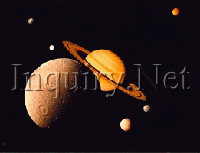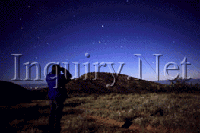A "Scout" can be defined as a trained and experienced observer. He learns about nature and how to be at home in the out-of-doors. He develops skills that help him explore the unknown. Part of our natural environment is in the sky above. Skilled observations of the stars also provide information about time, directions, and positions.
Knowledge of our stellar environment can help develop our personal understanding of man, on a planet, in space; observing for only a flash in time. Scouts and leaders have unique opportunities to observe the night sky -- free from the common obstructions of atmosphere, horizons and time. Check out the BSA Handbook and Fieldbook to become experienced observers of our environment in space. "Be prepared" for a clear night sky.
All Scouts should have the Opportunity to:
| Find the north star -- use
dippers and "W' constellations. | |
| Use sun, moon, and north star for
directions and time. | |
| Find 12 Zodiac constellations and solar system objects
(exclusive path of sun, moon and planets): Aries, Taurus, Gemini, Cancer, Leo,
Virgo, Libra, Scorpio, Sagittarius, Capricorn, Aquarius, Pisces. | |
| Find
overhead seasonal star patterns: S Summer triangle --Vega, Deneb, Altair F Fall square -- part of Pegasus constellation W Winter hexagon -- Sirius, Rigel, Aldebaran, Capella, Pollux, Procyon (Sp Spring arc big dipper handle, Arcturus, Spica S. | |
| Read star maps find
objects in night sky. | |
| Skillfully observe: meteors, planets, eclipses, occultations, other events. |
How to Be Prepared to observe transient events: bright meteors, comets, northern lights, nova, eclipse, etc.
Activities and Fun with:
| Visit Planetarium (ask for Astro Merit Badge program?). | |
| "Sun is a basketball" game -- divide sizes and distances by 5 billion. | |
| Star Wheel map - rising, setting, time, horizon view and calendar. | |
| Magazine map --constellations, names, planet positions. | |
| Star atlas -- coordinates, binocular objects, plotting "new" objects. | |
| Up-to-date information in Astro magazines and almanac; plan to observe future events. | |
| 3D field Astrogeometry -- positions and angles, demo. | |
| Planet position map -- move them around. | |
| Camp out under the stars. Meteor watch. |
Hang onto your Seat!
| Our planet rotates with an equator surface speed of
1,000 miles/hour. | |
| Our planet also orbits the sun at a speed of
19miles/second. | |
| Our sun is also moving towards a point in the milky way galaxy
at a speed of 12 miles/second. | |
| Our milky way galaxy also has a rotational
speed of 150 miles/second. | |
| Our milky way galaxy also appears to be leaving a fixed point in space at 400 miles/second. This is what the astronomers have observed -- so far! |
RESOURCES FOR OBSERVATIONAL ASTRONOMY
| BSA Handbook and Fieldbook have sky maps and star-study information. | |
| Star wheel maps. Dial calendar and local time positions map for your
horizon. BSA #01055? | |
| Sky Calendar publication $7.50/year Abrams Planetarium, Michigan State University, East Lansing, MI 48824. | |
| All about Telescopes by Sam Brown, #9094 $14.95 paperback;
Edmund Scientific Co., 101 E. Gloucester Pike, Barrington, NJ 08007. | |
| Backyard Astronomy I &II, #SO013, $5. 00 Sky Publishing
Corp., P.O. Box 9111, Belmont, MA 02178. | |
| Field Guide to Stars and Planets by Menzel and Pasachoff.
Peterson Field Guide Series #15, $15. 95; paperback; most book stores. | |
| Monthly magazines: Astronomy or Sky & Telescope, most newsstands. | |
| Visit your local planetarium, library, museum, astronomy club, science center, nature center or astronomical observatory. |
TELESCOPES: HELPFUL HINTS
| Binoculars are the best "telescope" for many reasons: cheap, easy
to aim, wide field, bright image, easy to keep clean, very portable. If you have
difficulties with binoculars a telescope will be worse! | |
| Go to an astronomy clubs' observing session. Try various telescopes and
trade owners information and experiences. | |
| Many amateur astronomers build their own telescopes for important reasons.
They have learned how to avoid expensive shortcomings of factory telescopes. | |
| Get a Star Atlas and use it with binoculars to find all the objects you
might be interested in. T his experience is needed to aim even the simplest
telescope. | |
| What you view through a telescope will rarely look like the million-dollar
observatory photographs shown in full color publications. The few bright
objects, will look similar but smaller. Amateur photographs require skill,
effort, luck, and significant expense. | |
| Many telescopes collect dust in closets or basements. Some are too big to
transport out of city lights, too complex to reassemble and set-up, too flimsy
to aim and control, too dirty or abused, or the owner doesn't know enough about
interesting objects or how to find them in the night sky. | |
| Sky & Telescope and Astronomy magazines
advertise telescopes, accessories and components for home-builts. Technical
telescope building information and detailed observing diagrams are also
featured. A couple years of magazine reading and numerous astronomy club
contacts have shown excellent results for telescope acquisition and use. | |
| Visit your local planetarium and take astronomy courses at your nearby college. The science of astronomy has many recent developments and discoveries that up-date previous theories and observations. Library material and television programs contribute to a casual education and help inspire your own observations. |
 offers materials that relate to two
Boy Scout Merit Badges. They are the Astronomy badge and the Space
Exploration badge. Click on the link above to go directly to theses
resources. Use your browser "BACK" button to return to this page.
offers materials that relate to two
Boy Scout Merit Badges. They are the Astronomy badge and the Space
Exploration badge. Click on the link above to go directly to theses
resources. Use your browser "BACK" button to return to this page.
 Abrams
Planetarium Skywatcher's Diary
Abrams
Planetarium Skywatcher's Diary
Each month, the Department of Physics and Astronomy at Michigan State University makes the Skywatcher's Diary available over the Internet.
A collection of resources and links for people who watch and gaze at the night sky.
